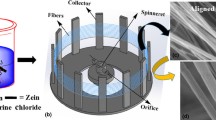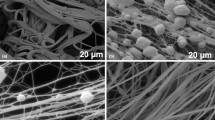Abstract
For the first time, protein fibers with excellent mechanical properties and water stability have been produced from gliadin for potential use in tissue culture and other medical applications. Biomaterials developed from plant proteins such as zein and soyproteins are preferred for several medical applications over synthetic polymers such as polylactic acid. However, the plant protein based biomaterials developed so far have poor mechanical properties and hydrolytic stability even after crosslinking. This study aims to develop biomaterials from gliadin with excellent mechanical properties and water stability without using any crosslinking agents. A novel gliadin fiber production method was used to self crosslink the fibers and obtain high strength and water stability. Gliadin fibers have high strength (120 MPa) and elongation (25%) compared to similar collagen fibers that were crosslinked with glutaraldehyde (strength of about 44 MPa and elongation of 14%). The fibers show 100% strength retention after being in pH 7 water at 50 °C for 40 days and also have better water stability than PLA in acidic conditions at high temperatures. Gliadin fibers are suitable for cell growth and promote the attachment and proliferation of bovine turbinate fibroblasts.






Similar content being viewed by others
References
C. M. VAZ, M. FOSSEN, R. F. TUIL, L. A. GRAAF, R. L. REIS, A. M. CUNHA, J. Biomed. Mater. Res., 65A (2003) 60
Y. P. KATO and F. H. SILVER, Proceedings of the annual international conference of IEEE engineering, November 9–12, Seattle, WA, 1989
L. BUTTAFOCO, N. G. KOLKMAN, P. E. BUIJTENHUIJS, A. A. POOT, P. J. DIJKSTRA, I. VERMES, J. FEIJEN, Biomaterials, 27 (2006) 724
Q. LU, K. GANESAN, D. T. SIMIONESU, N. R. YVAVAHARE, Biomaterials, 25 (2004) 5227.
J. DONG, Q. SUN, J. WANG, Biomaterials, 25 (2004) 4691
S. GONG, H. WANG, Q. SUN, S. XUE, J. WANG, Biomaterials, 27 (2006) 3793
P. H. MUNOZ, A. KANAVOURAS, R. VILLALOBOS, A. CHIRALT, J. Agric. Food. Chem., 52 (2005) 7897.
P. H. MUNOZ, A. RUBIO, J. M. LAGARON, R. GAVARA, Biomacromolecules, 5 (2004) 415
P. H. MUNOZ, A. KANAVOURAS, J. M. LAGARON, R. GAVARA, J. Agric. Food Chem., 53 (2005) 8216
N. REDDY, Y. YANG, Biomacromolecules, 8 (2007) 638
A. GENNADIOS, C. L. WELLER, Food Techn., 44(10) (1990) 63
H. C. HUANG, E. G. HAMMNOND, C. A. REITMEIER, D. J. MYERS, JOACS, 72 (1995) 1453
R. A. BOYER, Indl. Engg. Chem., 32 (1940) 1549
V. STELLA, P. VALLEE, P. ALBRECHT, E. POSTAIRE, Int. J. Pharm., 121 (1995) 117
C. DUCLAIROIR, A. M. ORECCHIONI, P. DEPRAETERE, F. OSTERSTOCK, E. NAKACHE, Int. J. Pharm., 253 (2004) 133
A. C. BECKWITH, J. S. WALL, R. W. JORDAN, Arch. Biochem. Biophys., 112 (1965) 16
Y. YANG, L. WANG, S. LI, J. Appl. Polym. Sci., 59 (1996) 433
J. F. CAVALLARO, P. D. KEMP, K. H. KRAUS, Biotechnol. Bioeng., 46 (1994) 781
Acknowledgements
This research was partially supported with funds from Nebraska Wheat Board, The Consortium for Plant Biotechnology Research, Inc by DOE prime agreement No. DE-FG36-02G012026, Archer Daniel Midland Company, USDA Hatch Act, the Agricultural Research Division at the University of Nebraska-Lincoln and by Multi State Research Project S-1026. The financial sponsors do not endorse the views expressed in this publication. We also thank Dr. Liping Xie at the Veterinary Diagnostic Center for her help in the cell culture experiments and Ying Li for her help in the electrophoresis and water stability studies.
Author information
Authors and Affiliations
Corresponding author
Rights and permissions
About this article
Cite this article
Reddy, N., Yang, Y. Self-crosslinked gliadin fibers with high strength and water stability for potential medical applications . J Mater Sci: Mater Med 19, 2055–2061 (2008). https://doi.org/10.1007/s10856-007-3294-0
Received:
Accepted:
Published:
Issue Date:
DOI: https://doi.org/10.1007/s10856-007-3294-0




